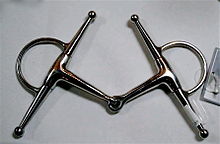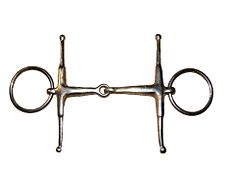Bit ring
The loose ring is currently one of the most popular overall designs, but several years ago the eggbutt and dee-ring were quite common.
Disadvantages: the loose ring may pinch the corners of the lips as it rotates, causing pain to the horse.
Rings may be larger on gag bits, especially if the rider wishes to increase the severity.
The loose ring is the most common bit seen at the lower levels of dressage and on junior horses in western riding disciplines.
It is also seen through all the levels of eventing (especially in the dressage phase), and is a common bit for race horses and some show jumpers.
Action: the eggbutt has a slightly oval (egglike) shape, and consists of a round outer ring attached to a more upright, straighter cheek which is fixed to the mouthpiece.
Uses: Eggbutts are overall one of the most popular ring designs, less common in the dressage arena than loose-rings, more often seen in show hunter disciplines.
Action: the Dee-ring, as its name suggest, has a ring shape like a "D" with the cheek side of the "D" attached to the mouthpiece of the bit.
The straight bars of the Dee-ring provide a slight lateral guiding effect.
The Dee-ring is fixed in the horse's mouth, because its shape does not allow the bit to rotate.
Uses: Another very popular design, the Dee-ring was the traditional bit used in hunt seat riding, and is still seen in that discipline.
A modified Dee-ring design with the straight side and a rounder ring is sometimes seen in western riding.
Types of Bits: snaffle Action: The cheeks of these bits extend both upward and downward, tapering as they get farther away from the mouthpiece, with a half-moon ring similar in shape to the Dee-ring or eggbutt (depending on the design).
The full cheek without bit keepers is more fixed in the mouth than a loose ring, and thus has a similar action to the eggbutt or Dee-ring.
Advantages: The full-cheek is not as likely to be pulled through the mouth as a loose-ring or eggbutt and gives considerable lateral commands.
In some cases, a young horse may be scared by the strong lateral pressure of the full cheek.
Uses: The full cheek is becoming more popular and is now seen in many disciplines, including dressage, eventing, show jumping, western riding and hunt seat.
The bit provides some lateral guiding effect, and is more fixed in the mouth than the loose ring.
Mouthpieces: Usually seen in smooth single- or double-jointed mouthpieces Uses: not as common in the United States as other bit rings, but seen in a variety of disciplines Type of Bit: snaffle, named after François Baucher, a 19th century French riding master whose theories are still widely followed.
This bit lies flat against the horse's face, is fixed in the mouth and concentrates pressure on the bars.
Contrary to common belief, the bit does not exert poll pressure unless it is put onto the bridle upside-down.








